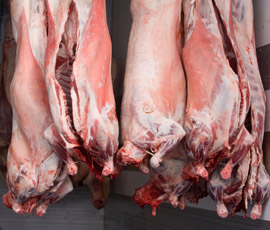EBLEX warns of new year lamb market challenge

EBLEX warns of challenging trading conditions for the new year lamb market and cautions producers not to over-finish.
Autumn- and winter-slaughtered lambs have a tendency to be over-fat, so producers are being urged by EBLEX to target the market and select stock for slaughter carefully to appeal to the broadest market and maximise returns.
“It’s been a poor year,” said Steve Powdrill, EBLEX national selection specialist. “Lambs have not finished and in these circumstances the tendency is for producers to over-finish their stock.
“There is going to be a carryover of lambs into the new year, which could create challenging trading conditions. The key action for producers is to look at the markets carefully now and select stock appropriately to hit the broadest market sector and subsequently achieve the best returns.
“Lambs have not finished and in these circumstances the tendency is for producers to over-finish their stock.”
Steve Powdrill, EBLEX national selection specialist
“If we look at the hogget trade earlier this year, lambs at 42kg were making 215p a kg liveweight in the spring, grossing at £90.30. Lambs taken on to heavier weights, with fewer market outlets, were discounted. For example, the average for a 47kg lamb in mid-March was 20p less and those hoggets that were taken to over 52kg saw the average slip a further 20p, averaging 175p a kg grossing or £91 a head. This is a trend that is likely to continue. With current high feed costs and tight winter forage supplies, which is more important: pence a kg or pounds a head?
“While mainstream weight ranges and classification targets cover 80% of the marketplace, and while there is a market for lambs that fall outside these, it comes at a price. Not only are there penalties at the abattoir, but fat can take almost four times more energy than flesh to lay down, so it will have cost to put that fat on. In-specification product is vital if we want to retain and grow our lamb market with consumers.”
The poor finishing conditions will mean a drop of more than 4% in the number of lambs slaughtered compared with 2011 – about 550,000 head fewer. UK lamb slaughterings in September were down 11% on the year, with throughputs in Great Britain falling by 13%.
Regarding the problems in early scanning results reported by Farmers Weekly, an EBLEX spokesman said that it could not comment on the market implications at this stage because it did not have solid data on the issue, but added that it would continue to monitor the situation.
